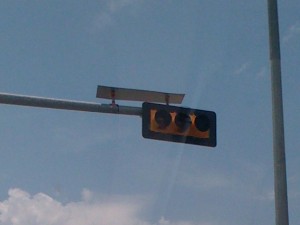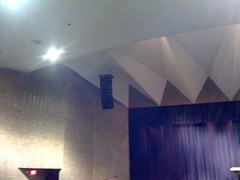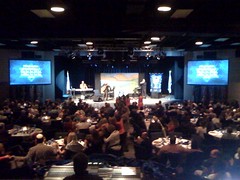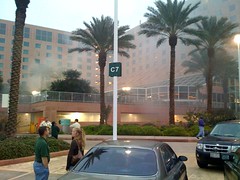 I was driving through Austin yesterday and there appears to be a sign on top of the stop lights that face up. To thin to be a solar panel. Are they for airplanes to see what road they can land on? Just found it interesting. If anyone has any insight let me know.
I was driving through Austin yesterday and there appears to be a sign on top of the stop lights that face up. To thin to be a solar panel. Are they for airplanes to see what road they can land on? Just found it interesting. If anyone has any insight let me know.
Category Archives: Random Thoughts
Team day
Today we made some time as a communications team to get out and have some fun. We were also saying good by to Richard and John as well. Even though it was hot it was good to hang out with good people.
I want to say thanks to John for his service and wish him the best in Alabama. I’m also pretty sure that he will really miss the Digico. 😉
Line Arrays
Tonight I’m at a choir concert at Lamar Consolidated High School
Auditorium. Much to my suprise when I looked up, they have a line
arrary system. Two lines with seven cabinets hanging under a single
sub setup in a stereo configuration. Just seems like this is the only
speaker configuration that people what these days. I guess that I
will find out in a few if this was installed because of its function
or to be trendy.
UPDATE: The choir concert was acoustic, didn’t even used the sound system so I guess I won’t know about the line array.
My Saturday Night
Paul Wibur performing and Pat Boone is up later. I know that you wish
you could be having this much fun.
—
Rick Russell
Designing for Success
 I have been reminded over the past few weeks of why so much attention must be put into designing things and processes. I don’t know where I heard it or who said it but it took me a while to understand the following statement “a properly designed road shouldn’t need traffic signs”. If you drive, have you ever seen a sign that was only needed because the road was not designed right or because of it’s surroundings was forced to be built in a way that required some form of instruction?
I have been reminded over the past few weeks of why so much attention must be put into designing things and processes. I don’t know where I heard it or who said it but it took me a while to understand the following statement “a properly designed road shouldn’t need traffic signs”. If you drive, have you ever seen a sign that was only needed because the road was not designed right or because of it’s surroundings was forced to be built in a way that required some form of instruction?
Some years back when I was in high school and college, I had the opportunity to work in a millwork shop. When we would build a cabinet door, we would usually install a door pull handle. Many times the door was easily opened without the handle, but by adding it anyone opening the door nows how it will open and which side to pull on. Same types of things applied to my IT positions. Lots of coders and interface designers try to write software and design interfaces that don’t require a user manual. Now as a producer that works with volunteers, I am constantly refining my processes and equipment to help the end user succeed. Something as simple as the order of the channels on a sound console can make a big difference is the success of the audio engineer.
If you are the designer and the end user then you have a fairly easy task. It never ceases to amaze me how something that I think makes perfect sense can be a challenge to some one else. So what is the key to good designs and processes? Observation and revision. My Grandfather told me about serving in the Pacific in World War II and the developments in anti-aircraft shells. A new shell was developed that could detect if an aircraft was in it proximity and it would explode. This is great stuff and eliminated the need for altitude fuses. The problem was if the shell didn’t find a plane it would not explode in the air and on its way down if a ship was in the area it would explode. The designers didn’t think of this issue and only after observing it in action, did they decide to make a modification so that it would explode at a set altitude if no planes were detected in it’s proximity.
Take the time to review your designs and processes in action with an open mind and make the necessary updates so that your users will succeed.
Changes 4/6/2008

This is a big Sunday for the tech ministry at Sugar Creek. We are going digital. The Digico is installed and this will be the first Sunday running it for the services. All is tested and ready to go and John is charged with making sure all works correctly. Over the next few weeks we will train the volunteers on the job. I think that they will be back running the shows soon as they become comfortable. We have had two rehearsal with the digital system and both were successful and the musician said they can hear a difference in the monitors. We have not even installed the version 2 Avioms yet. More to come on that next week.
We have a new (at least new since I have been producing) CG operator for the Edge service…welcome Janet. The Digico took up a lot of time this week, but I did get to add some curtian slashes behind the drums. I’m really looking forward to hearing the difference in sound quality over the next few weeks as well as how the A1 take to the new system.
Fire in the hotel garage
Trains
 These days I live in Sugar Land, TX. The family and I feel like we are on mission here. I was laying in bed this morning not sleeping because our dog was crying. That is another tale altogether. So I start hearing train horns and thinking that they seemed loud today. Now I have spent time in three cities in Texas and slept in about 10 hotels or houses. Only one of them was right next to the tracks (yes Eric, your apartment), but in each of them I remember hearing trains. I’ve come to the conclusion that is just a fact of life in Texas, or at least in the areas I have been. Our current house is 3/4 of a mile from the tracks as a crow flies based on Google Maps. The train doesn’t head toward our house and the 3/4 of a mile is the closet point the tracks come. So why do we need to hear the horn? You would think that some one could develop a more directional horn that doesn’t spread the sound 3960 feet to the left and right of the train. I have not been woken up by a train at this house, but Trisha and I are pretty sure the conductor is using the horn to keep himself awake.
These days I live in Sugar Land, TX. The family and I feel like we are on mission here. I was laying in bed this morning not sleeping because our dog was crying. That is another tale altogether. So I start hearing train horns and thinking that they seemed loud today. Now I have spent time in three cities in Texas and slept in about 10 hotels or houses. Only one of them was right next to the tracks (yes Eric, your apartment), but in each of them I remember hearing trains. I’ve come to the conclusion that is just a fact of life in Texas, or at least in the areas I have been. Our current house is 3/4 of a mile from the tracks as a crow flies based on Google Maps. The train doesn’t head toward our house and the 3/4 of a mile is the closet point the tracks come. So why do we need to hear the horn? You would think that some one could develop a more directional horn that doesn’t spread the sound 3960 feet to the left and right of the train. I have not been woken up by a train at this house, but Trisha and I are pretty sure the conductor is using the horn to keep himself awake.




